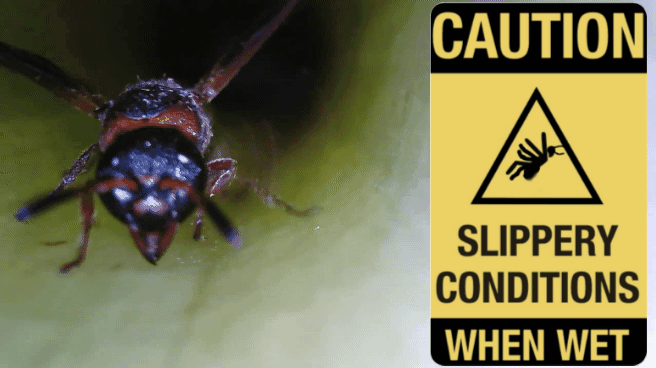
Thank you for stopping by my carnivorous plant (CP) website. A wide range of plants are carnivorous; they eat animals to survive, The most well known CP is of course, the Venus Fly Tap. Its leaf snaps shut on insect prey. And then there's the Drosera. Insects are attracted to their sticky leaves where they are captured and eaten. The American pitcher plant PP (Sarracenia) attracts insects into its leaves to be eaten.
Part of the popularity of the Venus Flytrap and the Drosera is that you can see whats happening to the insect prey. The pitcher plant's leaves are beautiful, but you can not see what's going on inside. (It has recently been speculated that Darwin preferred the Drosera and VFT because they were more exciting than the PP) Ants and other insects enter but you can only ask "What's happening?" Thanks to recent advances in microscopy we can now see what happens inside pitcher plants
And the answer is:
A LOT!
Disclaimer
Many ants were harmed in the making of these videos
The Teslong Pencam Microscope
These pictures were taken with the Teslong MS100 pencam, which is a 7mm wide, waterproof 1 megapixel endoscopic camera. It's diameter is small enough that it fits inside most pitcher plant leaves. It allows you to noninvasively see what's happening inside. In the pictures below, you can see the where the pencam is because you can see the pencam lights through the leaves. In the typical pitcher plants, such as the S. Judith Hindle and the S. Bugbat, the camera is easily focused with the dial at the top of the pencam. In a giant pitcher plant, such as S. Leucophylla, the pencam is deep in the pitcher You have to focus it before going in. It takes a bit of trial and error but reliably give good pictures.
Click below for a review of the Teslong pencam.
 |  |  |
|---|

We're a long way from Darwin's microscope
https://www.sciencephoto.com/media/723617/view/charles-darwin-s-microscope-1865
Welcome to the Hooker Zone

If you were expecting the Red Light District,
Shame on you.
Hooker zones refer to the distinct areas of the pitcher plant. As explained by Dr. Barry Rice at sarracenia.com
Zone 1 (Attraction): This zone is the part of the plant that is dedicated mostly to attracting prey. On Sarracenia, this is the pitcher lid. The lid has many nectar glands, and is often brightly colored and, as in the case of Sarracenia leucophylla, even perfumed. Insects are drawn to feed on the nectar. Prey that forage to the underside of the lid discover that it is slick. The lids of some species are covered with hairs that point towards the pitcher mouth, so they have a secondary function in ushering prey towards death.
Zone 2 (Conduction): This area includes the pitcher lip and extends a little way into the pitcher, and functions to conduct prey into the pit of doom. It is characterized by bright coloration and a particularly heavy amount of nectar secretion. Zone 2 may be a nice place to hang out and sup, but one mistake means plunging into the pit. The conduction zone has a kind of velvety sheen to it.
Zone 3 (Glandular): This zone is deeper still in the pitcher. The walls are slick, hairless, and rich with sunken glands that exude digestive fluid. Bugs in this zone are pretty much toast because they cannot scale the walls. Furthermore, there probably is not enough room for them to use their wings (if they have them) to fly to freedom.
Zone 4 (Digestion/absorption): The pit at the bottom of the pitcher is flooded with fluid laced with digestive enzymes, and hungry commensals prowl its depths. Downward pointing hairs make it even harder to escape. The pitcher walls lack a well-developed cuticle (the waxy layer that coats most plant parts), so nutrients can easily be absorbed by the plant. Some scientists think this whole zone should be considered a single gigantic gland.
There is a Zone 5, but its function is unknown and its only found in a few species. Because its below where the pencam can see, its mystery function is moot and I'll be ignoring it.

http://www.sarracenia.com/faq/faq5521.html
The pencam allows you to see the Hooker Zones. Zones 1 and 2, the attraction and conduction zones, sort of blend together. You can see the plants downward pointing hairs and the "windows" and veining. Ants and other insects are always there. Heading down
You can see where Zone 3, the Glandular zone, begins. (And it's easier as the plant matures. The Zone 3 seems to darken with time) And it's not just that you can see the Zone 2-3 demarcation, it's that you can see the difference from the insect’s perspective. You can frequently see an insect run all of the way up from bottom of Zone 3 until it hits the slick surface of Zone 2. An excellent example is of a wasp trapped in an S. Leucophylla, one of the taller plants.
The pencam highlights the Zone 2-3 boundary. When the pitcher is lit by sunlight, it is hard to see the distinction between the zones. Turn on the pencam lights and it is immediately. obvious. Zone 2 brightens and zone 3 turns a darker green. (I think it is the same substance that makes zone 2 slippery also makes it brighter.) This poor bee trapped in an S. Leucophylla illustrates the effect. The first picture is with the pencam lights off and the second is with them on.

Another interesting example is of a swarm of ants in a S. Bugbat. (I don’t know how many ants were in there, but it looks like dozens.) The ants formed a ladder of sorts to get themselves out of the zones 3 and 4, but alas, they could only make it to the the slick spot of zone 3.

And last, but not least, the pencam allows you to explore Zone 4, the digestion zone, Zone 4 is an insect nightmare. Not only is it an insect graveyard, but you can see the little monsters that live down there that eat the dead insects. The digestive zone of a pitcher plant is a vast, complicated food web.of animals that feed on the dead insects and help digest their food. These little monsters are extremely small. Too small for the pencam to get a good picture of the individual monster, but it excels at capturing vast, squirming mayhem as masses of monsters eating their prey.
Below is a near dead fly covered in little white blobs in a S Judith Hindle.

In a S. Judith Hindle pitcher, a little white blob can be seen crawling across a fly's compound eye.
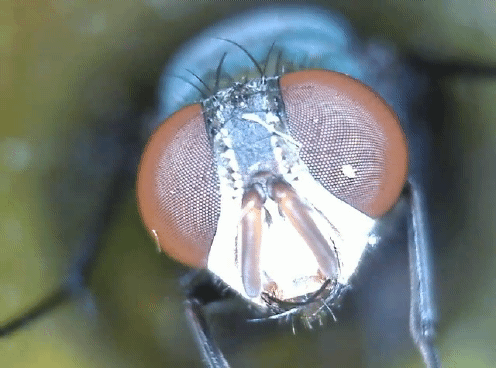
Four days later,, that same fly has died and is now being eaten by the little white blobs.
For some reason, several blobs appear to be dancing on the end of the fly's proboscis.
Very creepy.
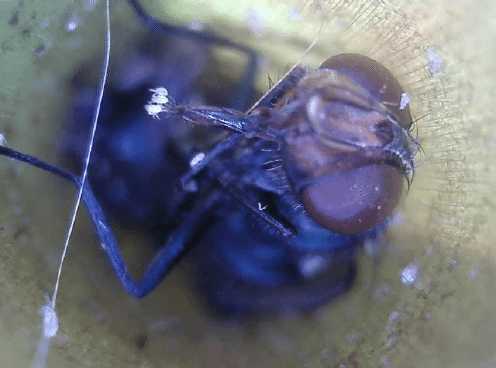
Here is a ton of blobs in a Sarracenia x catesbaei purpurea x flava. You can see why I've been calling these little guys "The Blobs". They are more commonly known as "slime mites".
I prefer blobs.
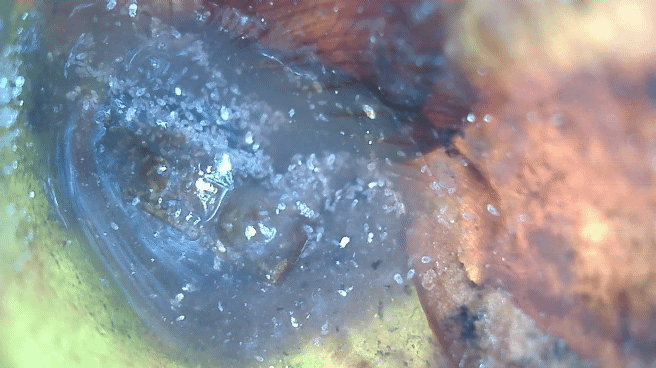
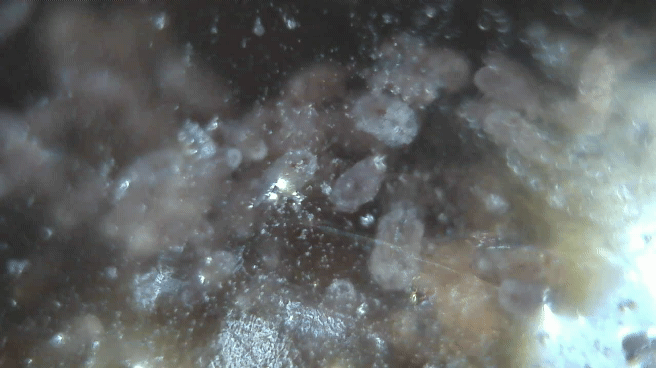
And there are larger monsters living inside the pitcher plants. The larva of midges, flesh flies and mosquitoes are the top predators in the pitcher ecosystem.
Midge larva in a S. Judith Hindle pitcher
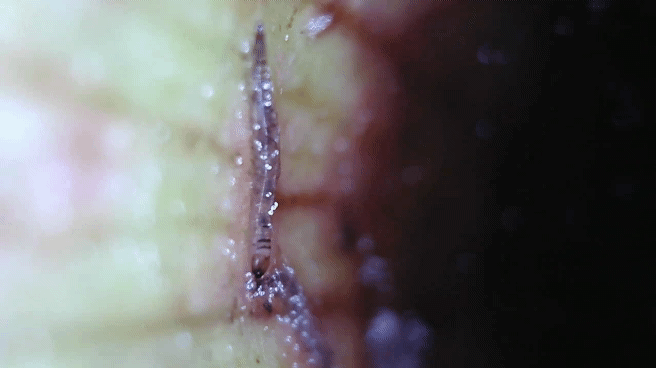
A flesh fly larva in a S. Yellow Jacket

For more detail on the blobs, midges, flesh flies and other monsters that lurk inside pitcher plants check out the link below or check out the blog. I'm always finding something new inside pitcher plants.



















